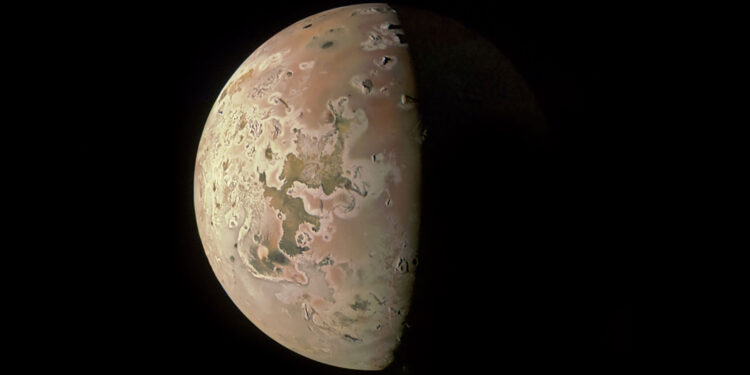This image revealing the north polar region of the Jovian moon Io was taken on October 15 by NASA’s Juno. Three of the peaks visible in the upper part of the image, near the day-night dividing line, were observed here for the first time. Credit: Image data: NASA/JPL-Caltech/SwRI/MSSS, image processing by Ted Stryk
On Saturday, December 30, NASA’s Juno spacecraft will conduct the closest flyby of Jupiter’s moon Io that any spacecraft has made in more than 20 years. Located about 1,500 kilometers from the surface of the most volcanic world in our solar system, the pass is expected to allow the Juno instruments to generate a wealth of data.
“By combining data from this flyby with our previous observations, the Juno science team is studying how Io’s volcanoes vary,” said Juno principal investigator Scott Bolton of the Southwest Research Institute in San Antonio, Texas. . “We’re looking at how often they erupt, how bright and hot they are, how the shape of the lava flow changes, and how Io’s activity is related to the flow of charged particles in Jupiter’s magnetosphere.”
A second ultra-close flyby of Io is planned for February 3, 2024, during which Juno will again come within about 930 miles (1,500 kilometers) of the surface.
The spacecraft monitored Io’s volcanic activity at distances ranging from about 6,830 miles (11,000 kilometers) to more than 62,100 miles (100,000 kilometers), and provided the first views of the north and south poles from the moon. The spacecraft also made close flybys of Jupiter’s icy moons, Ganymede and Europa.
“With our two close flybys in December and February, Juno will investigate the source of Io’s massive volcanic activity, whether a magma ocean exists beneath its crust, and the importance of Jupiter’s tidal forces, which press relentlessly this tortured moon.” Bolton said.
Now in the third year of its extended mission to study the origin of Jupiter, the solar-powered spacecraft will also explore the ring system where some of the gas giant’s inner moons reside.
This JunoCam image of Jupiter’s moon Io captures a plume of material ejected from the (unseen) volcano Prometheus. Indicated by the red arrow, the plume is barely visible in the darkness below the terminator (the line separating day and night). The image was taken by NASA’s Juno spacecraft on October 15. Credit: NASA/JPL-Caltech/SwRI/MSSS
Imagine this
All three cameras aboard Juno will be active during the Io flyby. The Jovian Infrared Auroral Mapper (JIRAM), which takes infrared images, will collect thermal signatures emitted by volcanoes and calderas covering the Moon’s surface. The mission’s Stellar Reference Unit (a navigational star camera that also provided valuable scientific data) will obtain the highest resolution image of the surface to date. And the JunoCam imager will take color images in visible light.
JunoCam was included on the spacecraft for public engagement and was designed to operate for up to eight flybys of Jupiter. Io’s next flyby will be Juno’s 57th orbit around Jupiter, where the spacecraft and cameras endured one of the most severe radiation environments in the solar system.
“The cumulative effects of all this radiation started showing up on JunoCam over the last few orbits,” said Ed Hirst, Juno project manager at NASA’s Jet Propulsion Laboratory in Southern California. “Images from the latest flyby show a reduction in the dynamic range of the imager and the appearance of ‘striping’ type noise. Our engineering team has been working on solutions to mitigate the damage caused by radiation and keep the imager operating.”
More Io, please
After several months of study and evaluation, the Juno team adjusted the spacecraft’s planned future trajectory to add seven new distant flybys of Io (for a total of 18) to the expanded mission plan. After Io’s close pass on February 3, the spacecraft will fly by Io in every other orbit, with each orbit gradually moving further apart: the first will be at an altitude of about 10,250 miles (16,500 kilometers) above ‘Io, and the last will be about 71,450 miles (115,000 kilometers) away.
Io’s gravitational pull on Juno during the December 30 flyby will reduce the spacecraft’s orbit around Jupiter from 38 to 35 days. Juno’s orbit will drop to 33 days after the February 3 flyby.
After that, Juno’s new trajectory will result in Jupiter blocking the spacecraft’s sun for about five minutes at the time the orbiter is closest to the planet, a period called perijove. Although this will be the first time the solar-powered spacecraft has encountered darkness since its flyby of Earth in October 2013, the duration will be too short to affect its overall operation.
With the exception of the February 3 perijove, the spacecraft will now encounter solar eclipses like this during every close flyby of Jupiter until the end of its extended mission, which ends in late 2025.
Starting in April 2024, the spacecraft will perform a series of occultation experiments using Juno’s Gravity Science experiment to probe Jupiter’s upper atmospheric composition, which provides key information about the shape and interior structure of the planet.
Quote: NASA’s Juno will take a close look at Jupiter’s volcanic moon Io on December 30 (December 29, 2023) retrieved December 29, 2023 from
This document is subject to copyright. Apart from fair use for private study or research purposes, no part may be reproduced without written permission. The content is provided for information only.



